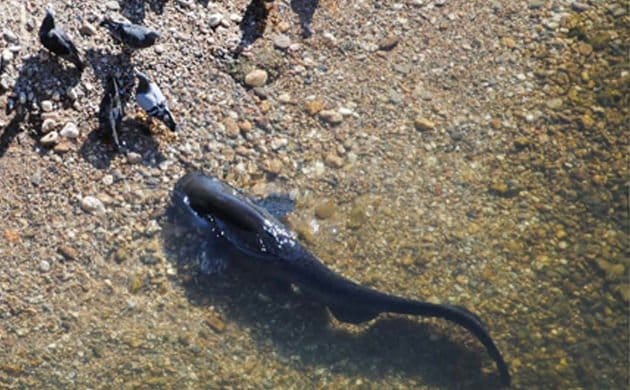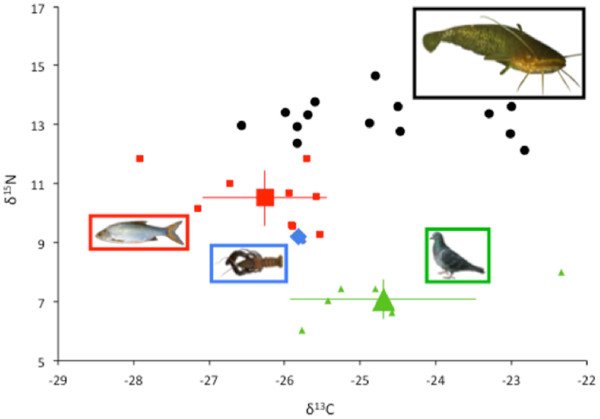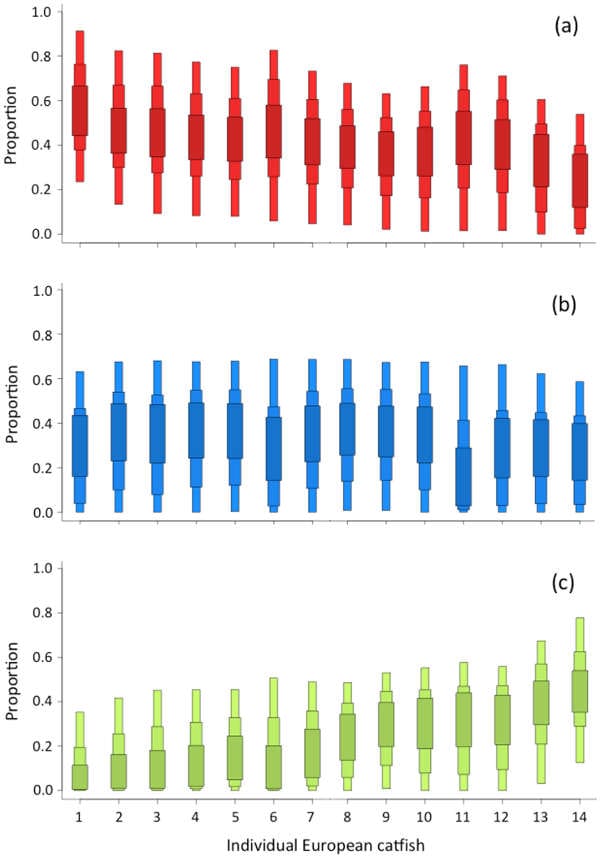
Usually, it’s “Bird eating fish” but here we have a case of a “Bird-eating fish.”
The Wels Catfish, Silurus glanis, is the second largest fish in its range, which covers much of Europe and parts of West Asia. In parts of Western Europe, it is considered to be “exotic” because it has been introduced, possibly by anglers, in lakes and rivers in France and the Iberian Peninsula. It has also found its way to Japan where it is considered to be an invasive species. It is sometimes known as the European Catfish.
![]() Like many catfish, Silurus glanis has a large head with beady eyes facing more upwards than sideways, and forages by hanging near the bottom in a hole or beneath cover. It detects prey using sight when conditions are clear, but mainly using its sense of taste which is facilitated by “taste buds” that are by no means confined to its tongue. From the vantage of the bottom feeder, the fish takes a variety of prey that passes by. Now and then individual catfish of various species hunt nearer the surface and larger catfish such as the American Channel Cat will take a duck or other water bird. So, the modal catfish is a fish that hunts from below, can take large prey, and occasionally eats a bird. For these reasons, it is not too surprising that one population the Wels Catfish has been observed to have a seemingly novel behavior: large individuals are taking preening pigeons off a gravelly island on the Tarn River in Southwestern France.
Like many catfish, Silurus glanis has a large head with beady eyes facing more upwards than sideways, and forages by hanging near the bottom in a hole or beneath cover. It detects prey using sight when conditions are clear, but mainly using its sense of taste which is facilitated by “taste buds” that are by no means confined to its tongue. From the vantage of the bottom feeder, the fish takes a variety of prey that passes by. Now and then individual catfish of various species hunt nearer the surface and larger catfish such as the American Channel Cat will take a duck or other water bird. So, the modal catfish is a fish that hunts from below, can take large prey, and occasionally eats a bird. For these reasons, it is not too surprising that one population the Wels Catfish has been observed to have a seemingly novel behavior: large individuals are taking preening pigeons off a gravelly island on the Tarn River in Southwestern France.
The fish charge at the shore and virtually beach themselves in an effort to grab the unwary birds, in the style of a Crocodile taking a Wildebeest or a Killer Whale taking a pinniped. Here is a video of some Wels Catfish foraging on Pigeons.
This interesting behavior was reported last month in the OpenAccess journal PLoS ONE. From the abstract of that paper:
The behavioral strategies developed by predators to capture and kill their prey are fascinating, notably for predators that forage for prey at, or beyond, the boundaries of their ecosystem. We report here the occurrence of a beaching behavior used by an alien and large-bodied freshwater predatory fish (Silurus glanis) to capture birds on land (i.e. pigeons, Columbia livia). Among a total of 45 beaching behaviors observed and filmed, 28% were successful in bird capture….Since this extreme behavior has not been reported in the native range of the species, our results suggest that some individuals in introduced predator populations may adapt their behavior to forage on novel prey in new environments, leading to behavioral and trophic specialization to actively cross the water-land interface.
There are lots of aquatic creatures that cross the water-land interface. Many fish, including various catfish but more famously trout, take insects flying over the water’s surface. Archer fish spit at invertebrates resting on overhanging vegetation to knock them into the water. As noted, the fish-like mammals do this as well. Some (but not most) killer whales beach themselves on land or ice to get at sea mammals or penguins, and some dolphins do similar things. Then there is the classic image of the giant octopus reaching out of the sea with its tentacles to drag an unwary sailor down to Davy Jones Locker. Except that last one doesn’t really happen, does it? Well, maybe not, but here is a case of a squid eating a Gull off the surface.
During this study, all the pigeon predation was observed on one small island where the birds grouped to preen and drink. Over several periods of observation, 54 breaching attempts, where the catfish came partially or mostly out of the water, were systematically observed and filmed. 28% of the time the fish got the bird, dragged it under water, and swallowed it. About 40% of the time, the fish was at least half out of the water during its attack. The breaching generally took between 1 and 4 seconds. Motionless pigeons seemed to be ignored. Pigeons that moved were sitting ducks.
Stable isotopes are version of elements that are all called the same thing (i.e. Carbon, Nitrogen, etc.) but that vary slightly in atomic mass. Various non biological and biological processes can sort isotopes out by their mass so that individual organisms in a certain environment or in a certain position in a food web will have a particular stable isotopic signature. So, if a predator eats mainly one kind of organism, that predator’s tissues will have a signature indicating its diet.
The main foods of Silurus glanis are Crayfish and fish, and for some Silurus glanis individuals, the occasional Pigeon. The research team reporting on these fish carried out a stable isotopic analysis to see what role Pigeons may play in the diet of these fish. It turns out that Crayfish are a sort of fallback, or mainstay, food for Silurus glanis while the percentage of Pigeon varies a great deal across individuals, and possibly, for some individuals Pigeons partially replace fish to a certain degree. This leads to speculation that some large bodied and voracious Silurus glanis may have turned to birds after reducing availability of fish in their own habitats. This could explain why Silurus glanis are observed to eat birds only in as aliens in a habitat to which they were introduced, and not in their native home range. Or, it could just be some weird thing one group of catfish do.
The following graph shows the distribution of stable isotopes of Nitrogen (vertical axis) and Carbon (horizontal axis) for Crayfish, fish, and Pigeons based on samples taken at the site or from a nearby Pigeon hunting society. Note that the three prey types have distinct isotopic signatures. Since the Catfish eat these animals, they are made up of tissues that combine these signatures and further alter them in expected ways (black dots). The catfish are higher on the food chain which moves them up on the graph in terms of nitrogen, and they eat a range of prey which spreads them out across the horizontal axis. The Pigeons are distinct from the Crayfish and fish because they are not aquatic. Notable is the high degree of variation among the sampled catfish; only some of the fish are eating pigeons.
The following graph based on the isotopic analysis shows the decreasing contribution of fish (top series) and corresponding increase of Pigeon (bottom series) while Crayfish stay roughly the same (middle series) across a range of sample catfish tissues.
There might be a size effect among the catfish. Eating large prey is not possible for the smaller individuals, and the largest catfish seem to eat fewer pigeons. Catfish in the range of 1.0 to 1.5 meters seem to eat more pigeons than others. (The range of size of sampled catfish ranges from 0.9 to 2.0 meters.)
I have the impression that catfish often feed extensively at night. My own experience at catching catfish (big ones!) in Central Africa and in the US is that they are more active at night. Also, one hears things, on lakes, when the sun and moon are not shining. I would not be surprised if catfish, with their low degree of reliance on sight, feed off the surface or at the water’s edge more often than we think. I would hypothesis that certain aspects of the observed behavior reported in this study is less unique than indicated. This could partly explain what happens to all those baby ducks as the summer progresses! Still, if there was regular diurnal feeding on preening and drinking birds by large catfish we would probably know about it. Clearly, there is something unique going on here.
_______________
Cucherousset, J., Boulêtreau, S., Azémar, F., Compin, A., Guillaume, M., & Santoul, F. (2012). “Freshwater Killer Whales”: Beaching Behavior of an Alien Fish to Hunt Land Birds PLoS ONE, 7 (12) DOI: 10.1371/journal.pone.0050840















Leave a Comment